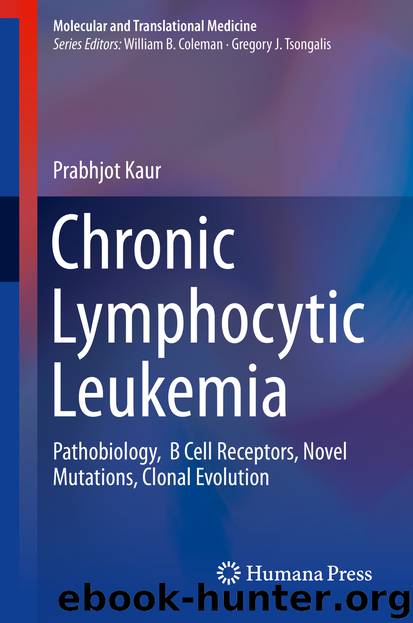Chronic Lymphocytic Leukemia by Prabhjot Kaur

Author:Prabhjot Kaur
Language: eng
Format: epub
Publisher: Springer International Publishing, Cham
Soon it was realized that antigen-binding site restrictions were not specific to IGHV3-21-expressing CLL but involved most of the CLL IG repertoire. Several studies show the presence of “stereotyped” Vh CDR3 sequences among CLL BCRs, and some find that at least 30% of CLL cases can be categorized into one of several subsets based largely on stereotyped amino acid motifs [32, 33]. Darzantes et al. demonstrate that the IgHV gene repertoire restrictions typical of CLL are limited to stereotyped cases and can be segregated clearly from “heterogeneous” (nonstereotyped) cases and suggest, therefore, that these two groups may have different developmental histories [34]. Messmer et al. and others [29, 31, 35, 36] coin this as “stereotyped antigen receptors ” from the Greek stereos (solid, uniform) type, as a phenomenon of highly similar B-cell receptors (BCRs) being found in CLL cells of unrelated patients. The identification of stereotypy among unrelated and geographically distant cases is taken as indirect evidence for antigen binding and stimulation that contribute to clonal selection and expansion as well as disease promotion [7, 31, 35, 36]. Further proof of role of antigen in CLL pathogenesis comes from studies that show that molecular structures present on apoptotic cells or infectious antigens are identified as antigens bound by stereotyped BCR [37, 38]. mAbs usually recognize two types of antigens: native molecules located within healthy cells, which relocate to the external cell surface during apoptosis, and/or neoantigens, generated by oxidation during the apoptotic process. Some of the latter epitopes are similar to those on bacteria and other microbes. Catera et al. show that 60% of CLL mAbs bound to the surfaces of apoptotic cells, are polyreactive, and express unmutated IgHV. Their study included recombinant mAbs from 19 U-CLL and 9 M-CLL that utilized IgHV most commonly observed in CLL such as 1–69, 3–21, 4–34, and 4–39 and include several mAbs that show CLL specific stereotypic rearrangements.
The criteria for stereotypy has evolved over time [34, 35, 39]. The current criteria of stereotypy are based on evidence that IgHV genes are phylogenetically related, that is, they originate from three ancestral phylogenetic clans: IgHV1/5/7 subgroup genes from clan I, IgHV2/4/6 from clan II, and IgHV3 genes from clan III. This grouping of mammalian immunoglobulin VH families into three distinct clans is based upon sequence conservation in two of the three framework (FR) intervals that promotes preservation of protein sequence and structure (which means that their primary sequences are closely homologous), came from Kirkham et al. and not only provides a structural context for theories that address differential use of VH families in the immune response but also forms the basis of defining stereotypy [40]. The current accepted criteria for stereotypy embraces the Kirkham et al. delineation of sequence conservation within a clan and requires that only IGHV–IGHD–IGHJ gene rearrangement sequences carrying IGHV genes of the same clan (I, II, or III) can be assigned to the same cluster; in addition, connected sequences must share identical VH CDR3 lengths, exact amino acid positions within the VH CDR3 region, and at least 50% amino acid identity and show 70% similar amino acid properties.
Download
This site does not store any files on its server. We only index and link to content provided by other sites. Please contact the content providers to delete copyright contents if any and email us, we'll remove relevant links or contents immediately.
When Breath Becomes Air by Paul Kalanithi(7256)
Why We Sleep: Unlocking the Power of Sleep and Dreams by Matthew Walker(5637)
Paper Towns by Green John(4165)
The Immortal Life of Henrietta Lacks by Rebecca Skloot(3821)
The Sports Rules Book by Human Kinetics(3582)
Dynamic Alignment Through Imagery by Eric Franklin(3483)
ACSM's Complete Guide to Fitness & Health by ACSM(3462)
Kaplan MCAT Organic Chemistry Review: Created for MCAT 2015 (Kaplan Test Prep) by Kaplan(3419)
Introduction to Kinesiology by Shirl J. Hoffman(3297)
Livewired by David Eagleman(3117)
The River of Consciousness by Oliver Sacks(2989)
Alchemy and Alchemists by C. J. S. Thompson(2909)
The Death of the Heart by Elizabeth Bowen(2897)
Descartes' Error by Antonio Damasio(2728)
Bad Pharma by Ben Goldacre(2724)
The Gene: An Intimate History by Siddhartha Mukherjee(2489)
Kaplan MCAT Behavioral Sciences Review: Created for MCAT 2015 (Kaplan Test Prep) by Kaplan(2487)
The Fate of Rome: Climate, Disease, and the End of an Empire (The Princeton History of the Ancient World) by Kyle Harper(2431)
The Emperor of All Maladies: A Biography of Cancer by Siddhartha Mukherjee(2427)
